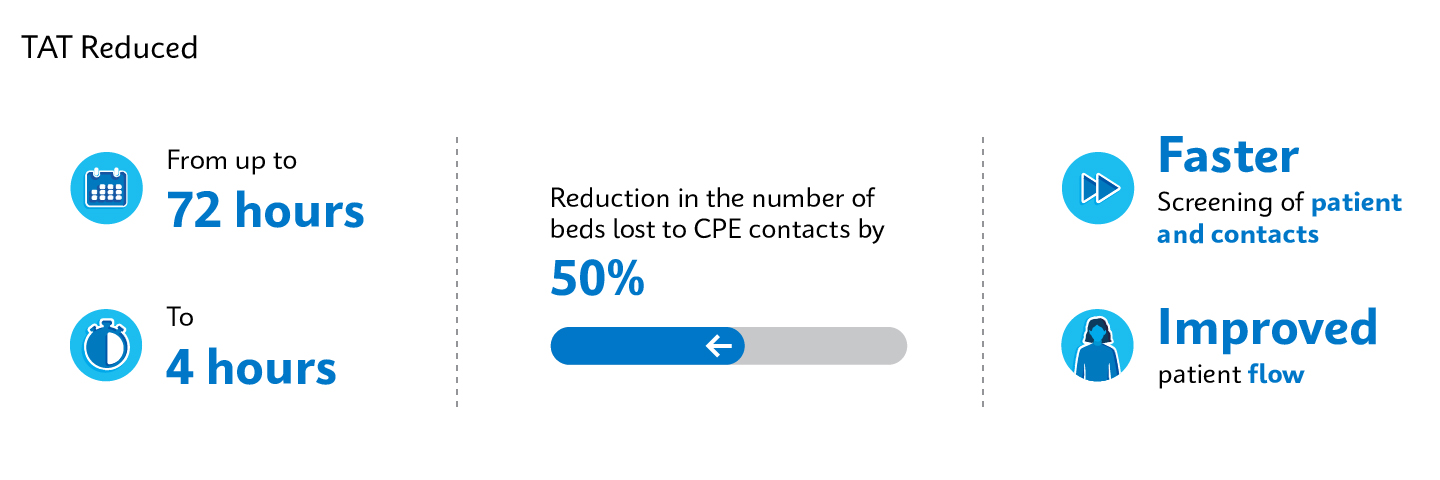3m Read
November 19, 2024
ANTIMICROBIAL STEWARDSHIP
Impact Story
PCR Screening at a British Hospital Enables Timely Infection Control
At Royal Liverpool and Broadgreen University Hospitals NHS, the turnaround time for carbapenemase-producing enterobacterales (CPE) testing using culture and phenotypic confirmation was up to 72 hours.
Because there was a lack of rooms to isolate the patients at the hospital, patients could be released before their test results were available.
This delay increased the risk of the spread of CPE, resulting in the loss of beds and ward closures to prevent further spread of CPE. The cost of losing a single bed was £200 a day, amounting to £150,000 if a ward with 25 beds was forced to shut down for a month.
There was a critical need for a faster CPE screening method to eliminate the possibility of patients spreading CPE or being discharged before they received their test results.
In order to avoid delays and prevent the spread of CPE, the Royal Liverpool and Broadgreen University Hospitals NHS Trust implemented PCR-based CPE testing using the Xpert® Carba-R test on a GeneXpert® Infinity system to enable faster screening. The Xpert Carba-R test provides results in 50 minutes, significantly reducing the total turnaround time (TAT) from 72 hours to 4 hours.
The expedited TAT allowed room bays to be decanted and decontaminated quickly, reducing the number of beds lost to CPE due to contamination measures by 50%.
"The introduction of rapid molecular testing for carbapenemase-producing enterobacterales allowed us to shorten the time to result to a matter of hours instead of days, identify patients quickly and take the necessary precautions quickly."
-- Dr. Tim Neal, Mersey Programme Director Microbiology, Department of Microbiology Royal Liverpool University Hospital, Royal Liverpool and Broadgreen University Hospitals NHS Trust

Listen to Dr. Tim Neal, Mersey Programme Director Microbiology, Department of Microbiology Royal Liverpool University Hospital, Royal Liverpool and Broadgreen University Hospitals NHS Trust discuss infection control within his organizations.
“My name is Dr. Tim Neal, and I'm the infection control doctor at the Royal Liverpool University Hospital. I have wide-ranging responsibilities for all aspects of infection control and the science that I cover, and this includes advert organisms such as MRSA, VRE and CPE as well as dealing with such things as water safety and air safety in the organization as well.
In our organization, we've been on quite a steep learning curve with CPE. Initially we thought, and I think others think this also, that it isn't a big problem in their organization. However, once we started to look for this organism we found it and then we found more and this is despite taking very stringent division control measures and applying the national guidance as it is written.
I think CPE is a very significant threat at the moment, it's listed on the National Risk Register because I think we recognize that with the emergence of this organism and the potential of untreatable infections in the future is going to transform the way we practiced health care and the way patients are managed and the safety of those patients.
As these become more common, we will see more and more infections with these organisms making antibiotic treatment futile and patients will suffer as a consequence of this.
When we first started to screen for CPE we encountered significant challenges in this healthcare organization particularly in identifying sufficient isolation facilities for patients and occasionally this couldn't be done practically and we would cohort patients together sometimes we've had to close wards because of the number of patients we've had where we've had to implement restrictive measures to stop spread.
Laboratory procedures at the time, because it was a new test, it was a phenotypic test so we were culturing the organism, the turnaround time for them samples was significant sometimes as long as five days by which time a patient would have been in the hospital for that period of time and the potential to spread was significant and that was our greatest challenge.
We introduced molecular testing initially for contacts of patients in a ward environment and this allowed us to speed up the time or shorten the time that the ward would remain closed before we could re-admit to that particular ward area.
If we get to a point where we can identify patients on admission as being a carrier of this multi resistant organism, we could prevent any of them being admitted toward areas where they would have contact with other patients i.e. they could be admitted straight to an isolation facility or to an isolation room and that way both they would be protected and all the patients would be protected also.
Rapid molecular diagnostics as the name suggests provides us with a much more rapid result so that we can turn around a sample in a matter of hours and identifying patients quickly and take the necessary precautions quickly.
The time it takes to culture the organism using conventional methods is too long for practical infection control measures to be implemented successfully and that the more rapid you can make a diagnosis or the more rapidly you could identify a patient as a potential carrier that quickly can take precautions and prevent spread and that has been a significant finding for us.”
Learn more about PCR-based CPE testing using the Xpert® Carba-R test on the GeneXpert® Infinity system to enable effective screening.
CE-IVD. In Vitro Diagnostic Medical Device. May not be available in all countries.
*Projections and realized results are specific to the institution where they were obtained and may not reflect the results achievable at other institutions
Reference:
Corless, C E et al. “Impact of different carbapenemase-producing Enterobacterales screening strategies in a hospital setting.” Infection prevention in practice vol. 2,3 100011. 21 May. 2020 doi:10.1016/j.infpip.2019.100011
Read Next
MORE








